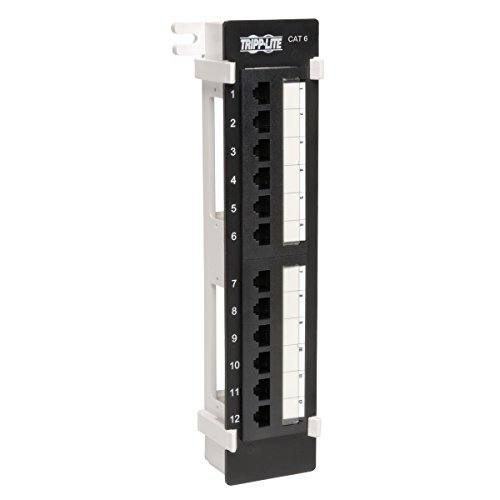(Part 2) Best patch panels according to redditors
We found 64 Reddit comments discussing the best patch panels. We ranked the 26 resulting products by number of redditors who mentioned them. Here are the products ranked 21-40. You can also go back to the previous section.






> Coax->Modem->Switch->14 cables in wall. Is this correct?
It has to go Coax->Modem->Router->Switch. Comcast will run Coax to your desired modem location, which in this case will be the wiring cabinet. If they can't, no big deal, you'll just need to use one of the installed Ethernet lines to connect the modem to the router or the router to the switch, depending on whether you put the router with the modem or in the wiring cabinet (I'd recommend the latter).
Since you're already thinking of getting UniFi access points (absolutely the right choice) you should get this router and this switch. It's only 16 ports, 18 if you count the SFPs, but you only have 14 lines anyway.
You'll terminate the cables at a patch panel. It's not hard to do, you just need something to strip the cable jacket and a 110 impact punch down tool to terminate the wires. You'll get a bunch of short patch cables to connect the switch to the patch panel, get the shortest length that'll reach. You don't want to skip the patch panel and put RJ45 plugs on the installed cables as it's much more difficult to do right than punch-down terminations and subjects the cables to more damage.
More than likely this is the case. The Blue is terminated and connected to what looks like RJ11 copper wires (phone). The Grey is attached to some sort of switch/router (ethernet). And the box looks like a Leviton box for which Leviton has a ton of accessories (Switches, Routers, Mounting hardware, patch panels).
Leviton Gigabit Switch - https://www.amazon.com/Leviton-47611-8GB-8-Port-Gigabit-Switch/dp/B00L3CEXU2
Leviton Patch Panel - https://www.amazon.com/Leviton-476TM-524-Twist-Mount-Patch/dp/B003O84ZW4/ref=sr_1_2?s=hi&ie=UTF8&qid=1482957791&sr=1-2&keywords=leviton+patch+panel
Leviton RG6 Splitter - https://www.amazon.com/Leviton-47690-6C2-Passive-Video-Splitter/dp/B002VJKAVM/ref=sr_1_2?s=hi&ie=UTF8&qid=1482958294&sr=1-2&keywords=leviton+splitter
Do not get their routers or access points. Get your own router (e.g. Unifi EdgeRouter X) and mount it in there and get a POE injector or two (if your router doesn't do POE) and mount it in there as well and then connect it to your Access Point (e.g. Unifi AP) at one of the Cat5E keystone jacks.
And while you're at it, I'd take the time and replace all the keystone jacks with Cat5e or Cat6 keystones.
Note: This statement only pertains to running cat 5e for computer networking, and not for audio video / other uses.
To write your house for a network, you'll run your wires like you would for telephone back to a central location. You can leave them hanging out of the wall but it's best to terminate them into either a structure wire panel, or into an X by Y wall plate. From there, you would use a switch / hub / router. At that point, you build your network as desired. If you want to know how to build a network, that's a much more involved answer.
An X by Y wall plate is just like any other wall plate in your house, but instead of having 1 or 2 RJ 45 jacks, would have multiple rows of them. A structure wire panel is kinda like a circuit panel for your low voltage stuff (structure wire). If can be a central hub for your Audio Video / Network / Phone systems, or any combination of the three. The advantage of a panel is it puts the wire and some of the equipment behind a wall, giving a cleaner look.
Lol I hate to break it to you but that is worth close to nothing, 10 bucks new on amazon http://www.amazon.com/C2G-Cables-Go-03859-Multimedia/dp/B00006MJFB/ref=sr_1_1?ie=UTF8&qid=1464457737&sr=8-1&keywords=2u+24+port+patch+panel free if you look hard enough
They are probably different colors so the installer knew which speaker went to which room. A piece of tape on the cables in the garage does about the same thing but I digress. Looks like 4 rooms worth of speakers? 4 separate bundles of cables? Looks like 8 total speakers, or at least 4 stereo speakers (meaning the left and right both go to 1 speaker).
Make sure you don't hook up all 8 to 1 source without something in the middle. I don't know the math, but each set of speakers changes the resistance causing problems with the amp. Use one of these to hook all the speakers up, then hook up a receiver.
https://www.amazon.com/Niles-VCS-HUB8-Control-Distribution/dp/B00092LNWI
If you want to control each room separately, you'd need to wire in volume controls for each set somewhere, but that's going to be more work.
https://www.amazon.com/Wall-Mount-Control-Knob-Wall/dp/B000V52CP0?ref_=ws_cp_c41569dcdeb0866f82ca_p_3_i_p
Well what you could do is cut a hole in the drywall and mount a box on that. That would give you enough space to see what is inside the wall. you could also cut a small hole and then use a camera like this https://www.amazon.ca/Endoscope-SGODDE-Waterproof-Inspection-Camera/dp/B01NCV35O2/ref=sr_1_4?ie=UTF8&qid=1540841693&sr=8-4&keywords=camera+inspection to look inside the wall. A snake camera or an endoscope. If it's an outside wall you will hit insulation and that can be problematic for drill bits. What is the outside wall? Brick? You'll need a masonry bit and a hammer drill. They aren't scary you just have to be careful that you don't shatter the brick, assuming your outside is brick of course.
You could put something like this https://www.amazon.ca/Tripp-N250-012-Mount-Feedthrough-Patch/dp/B000HZES42/ref=sr_1_3?ie=UTF8&qid=1540842096&sr=8-3&keywords=wall+mount+ethernet+panel at your demarcation point and cover up the hole in the drywall with a panel of some sort. The idea being of course that drilling the brick without having to go through other stuff is better. Make sure you put more insulation there and seal those holes so the nasty wind doesn't get inside.